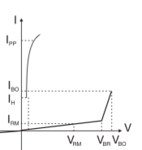davestew
Junior Member level 1
Hello all,
I have a question regarding the snapback behaviors of a nmos transistor (used in esd protection).
I understand that the nmos will enter in snapback behavior when its drain will exceed Vt1 and pull back the drain voltage to ~Vhold depending on the current entering the drain.
However, what I am not sure of is when does the nmos transistor exit its snap behavior/s-shaped I-V characteristic and fall back in the normal operation I-V characteristic. Is it when the current being pushed into the drain drops below Ihold, where Ihold is the corresponding current to the Vhold on the s-shaped snapback I-V characterisitic?
Any help will be appreciated
Regards,
Dave
I have a question regarding the snapback behaviors of a nmos transistor (used in esd protection).
I understand that the nmos will enter in snapback behavior when its drain will exceed Vt1 and pull back the drain voltage to ~Vhold depending on the current entering the drain.
However, what I am not sure of is when does the nmos transistor exit its snap behavior/s-shaped I-V characteristic and fall back in the normal operation I-V characteristic. Is it when the current being pushed into the drain drops below Ihold, where Ihold is the corresponding current to the Vhold on the s-shaped snapback I-V characterisitic?
Any help will be appreciated
Regards,
Dave
